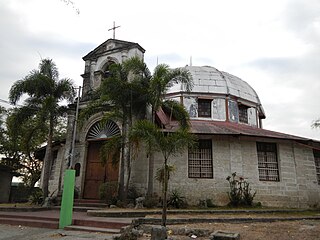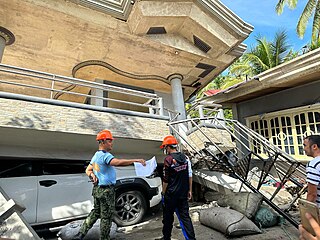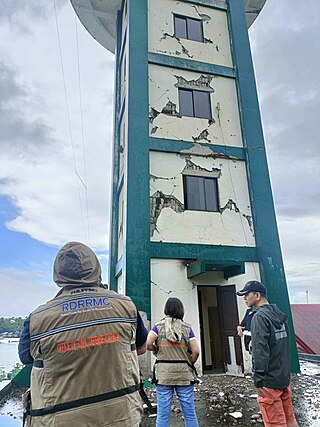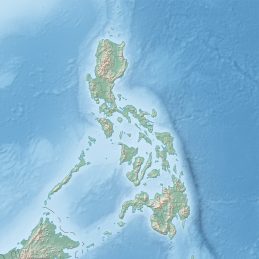
Castillejos, officially the Municipality of Castillejos, is a 3rd class municipality in the province of Zambales, Philippines. According to the 2020 census, it has a population of 67,889 people.

The 1990 Luzon earthquake occurred on July 16 at 4:26 p.m. (PDT) or 3:26 p.m. (PST) on the densely populated island of Luzon in the Philippines. The shock had a surface wave magnitude of 7.8 and produced a 125 km-long ground rupture that stretched from Dingalan, Aurora to Kayapa, Nueva Vizcaya. The event was a result of strike-slip movements along the Philippine Fault and the Digdig Fault within the Philippine Fault System. The earthquake's epicenter was near the town of Rizal, Nueva Ecija, northeast of Cabanatuan. An estimated 1,621 people were killed, most of the fatalities located in Central Luzon and the Cordillera region.

The 1968 Casiguran earthquake occurred on with a moment magnitude of 7.6 and a maximum Mercalli intensity of IX (Violent). The thrust earthquake's epicenter was in Casiguran, Quezon. A small non-destructive tsunami was generated and at least 207 people were killed. The majority of the deaths occurred in the collapse of a six-story building in Manila.
The 2012 Negros earthquake occurred on February 6 at , with a body wave magnitude of 6.7 and a maximum intensity of VII (Destructive) off the coast of Negros Oriental, Philippines. The epicenter of the thrust fault earthquake was approximately 72 kilometres (45 mi) north of Negros Oriental's provincial capital, Dumaguete.

The 2013 Bohol earthquake occurred on October 15 at in Bohol, an island province located in Central Visayas, Philippines. The magnitude of the earthquake was recorded at 7.2, with epicenter 6 kilometres (3.7 mi) S 24° W of Sagbayan, and its depth of focus was 12 kilometres (7.5 mi). It affected the whole Central Visayas region, particularly Bohol and Cebu. The earthquake was felt in the whole Visayas area and as far as Masbate island in the north and Cotabato provinces in southern Mindanao.

Holy Rosary Parish Church, also known as Santo Rosario Church, or the Pisambang Maragul, is a Roman Catholic church in Angeles City in the Philippines. It stands in the epicenter of the old Culiat town, now known as Angeles City. The church building is recognized by the National Commission for Culture and the Arts as a national historical site and as an important cultural property by the National Museum of the Philippines.

The San Vicente Ferrer chapel, popularly referred to as the Pio chapel is a Roman Catholic chapel located at Barangay Pio, in Porac, Pampanga. Built in 1861, the chapel is believed to be the first circular chapel of its kind in the Philippines. In 2019, a magnitude 6.3 earthquake caused the two pilasters on the chapel's facade to collapse.

The Santa Catalina de Alejandria Parish Church, also known as the Porac Church, is a 19th-century Baroque Roman Catholic church located at Barangay Poblacion, Porac, Pampanga, Philippines. The parish church is currently under the ecclesiastical province of the Archdiocese of San Fernando.
The 2017 Surigao earthquake occurred on February 10, 2017, at 10:03 PM (PST), with a surface wave magnitude of 6.7 off the coast of Surigao del Norte in the Philippines. According to the PHIVOLCS Earthquake Intensity Scale the earthquake was an Intensity VII (Destructive) earthquake at maximum. In the past Surigao province has been hit by a magnitude 7.2 tremor in both 1879 and 1893.

The 2017 Batangas earthquakes were an earthquake swarm that occurred from early April to mid-August 2017, affecting the province of Batangas in the Philippines and other nearby areas.
On July 6, 2017, a 6.5 magnitude earthquake hit Leyte, causing at least 4 deaths and 100 injuries. The quake also caused power interruptions in the whole of Eastern Visayas and nearby Bohol.
The 2019 Eastern Samar Earthquake struck the islands of Visayas in the Philippines on April 23, 2019 at 1:37:51 p.m. (PST).It had a moment magnitude of 6.5(Mww6.4 by USGS) and a local magnitude of 6.2 with a max intensity of VI based on the PHIVOLCS Earthquake Intensity Scale(PEIS). The epicenter was in San Julian, Eastern Samar and the hypocenter was at a depth of 64 km(~39.76 mi). As of April 30, 2019 there were 172 aftershocks ranging from magnitudes of 1.6 to 4.6. The earthquake injured 48 people and damaged about 245 homes.
On December 12, 1999, a 7.3 earthquake struck the northern coast of Zambales in the Philippines. It was felt in various provinces on the island of Luzon including as far north as Ilocos Norte and as far south as Quezon. This is the second earthquake with a magnitude of 7 to hit the area in 10 years with a 7.7 earthquake having occurred in 1990 which killed more than 2,000 people.

The 2019 Batanes earthquake was a magnitude 6.0 earthquake which struck Batanes, Philippines on July 27, 2019. It was preceded by a 5.4 magnitude foreshock. Nine people were killed by the combined effects of the earthquakes.
The 2019 Cotabato earthquakes were an earthquake swarm which struck the province of Cotabato on the island of Mindanao in the Philippines in October 2019. Three of these earthquakes were above 6.0 on the moment magnitude scale with a Mercalli intensity of VIII. More than 40 people have been reported dead or missing and nearly 800 were injured as a result of these events.
At 14:11 PST on December 15, 2019, the province of Davao del Sur on the island of Mindanao in the Philippines was struck by an earthquake measuring 6.8 . It had a maximum perceived intensity of VII on the Modified Mercalli Intensity Scale. At least 13 people were killed and another 210 injured.

On July 27, 2022, at 8:43:24 a.m. (PHT), an earthquake struck the island of Luzon in the Philippines. The earthquake had a magnitude of 7.0 Mw , with an epicenter in Abra province. Eleven people were reported dead and 615 were injured. At least 35,798 homes, schools and other buildings were damaged or destroyed, resulting in ₱1.88 billion (US$34 million) worth of damage.

At 16:14 PST on November 17, 2023, the province of Sarangani on the island of Mindanao in the Philippines was struck by an earthquake measuring 6.7 . It had a maximum perceived intensity of VIII (Severe) on the Modified Mercalli Intensity Scale. At least eleven people were killed and another 730 were treated for injuries.

On December 2, 2023, at 22:37 PST, a magnitude 7.4-7.6 earthquake occurred off the island of Mindanao in the Philippines. The shallow subduction earthquake killed at least three people and left 79 injured.

















